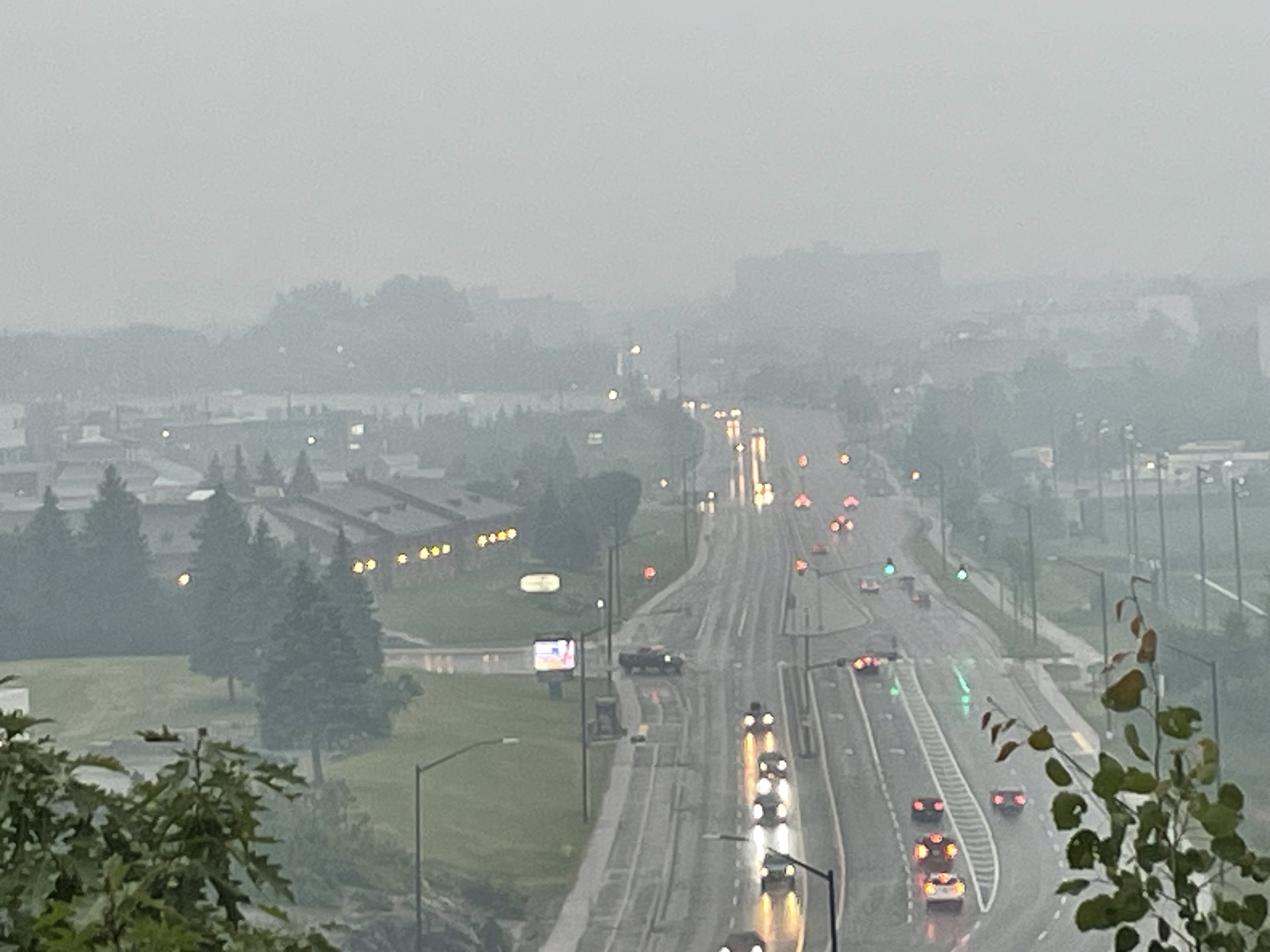Even after a heavy rainfall, the Air Quality Health Index reading outside the CHAT Media offices in Sudbury, Ont., was still 11+, the most severe rating possible.
More than 400 forest fires have been raging across Canada, breaking records at a time when the annual fire toll would not normally even be reaching its peak. Locations far away from those fires have been blanketed in thick smoke. And while air quality conditions in major urban centres like Toronto, Montreal, and even New York City have captured the headlines, even remote areas have suffered.
Air Quality Health Index readings in the “Very High Risk” zone have become commonplace, with advisories to avoid outdoor activities wherever possible. The AQHI is presented on a scale of 1 to 10+ with 4 health risk categories:
- 1 to 3 = low health risk
- 4 to 6 = moderate health risk
- 7 to 10 = high health risk
- Above 10 = very high health risk
Air quality index maxes out at 10 for forecasting purposes. But as an example, Ottawa’s readings actually hit as high as 14 on an internal scale, double the level required for issuing an air quality statement.
During smoky conditions, concentrations of fine particulate matter (PM2.5) override the health risks of the other two measured pollutants: ozone and nitrogen dioxide. The upper limit of “good” air quality from particulates is 12 micrograms per cubic metre. Ottawa saw concentrations of fine particulate matter of 267 micrograms per cubic metre, more than 22 times the “good” limit.
In short, it’s bad. Really bad. And as much as it affects us humans, it’s also true that our vehicles are “breathing” the same air.
While aftermarket parts professionals can do little about the quality of the air around us, they can recommend the right cabin air filters to help drivers breathe easier in their vehicles.
Engine intake filters are of course affected over time, and should be maintained, but a more critical concern is the passenger cabin air quality. According to Mann Filter, air flows into a vehicle at a volume of up to 540,000 litres per hour through the ventilation ducts.
“Imagine the amount of dirt and dust that comes with it. Now picture that entering your lungs. Not a pretty picture. In fact, the air inside a car contains around five times more exhaust gases, pollutants and allergens than outside air. Vehicle cabin air filters remove up to 90% of even the tiniest harmful particulates (up to 1µm in size), creating a barrier between passengers and the incoming air.”
Fortunately, filter technology has improved so much that the air inside a vehicle can actually be significantly better in quality than the surrounding conditions. That’s as long as those filters are in good working order to begin with, and the recent exposure to extremely poor air quality conditions will shorten the life of cabin air filters, pushing them over the edge before their time.
“Cabin air filters are the first line of defence against contaminants that reduce vehicle cabin air quality for vehicle owners and their passengers,” said Nathan Perrine, executive director of the Car Care Council back in 2020, when another spate of fires blanketed parts of the Western U.S. in smoke. “The Car Care Council recommends that motorists in areas impacted by wildfires and those in surrounding states have their cabin air filters replaced.”
Standard replacement intervals for cabin air filters are in the 15,000 km/one year range, but these are anything but standard conditions.
While it is certainly true that drivers should be advised to set their HVAC systems on “recirculation” during times of poor outside air quality, it is also true that many drivers will not do this, pushing cabin air filters to their capacity limits by constantly drawing in outside air, and everything it is carrying, through that cabin air filter.
For those who have heeded that advice, there are options:
Particle (Dust-type) Cabin Air Filters
Standard dust-type filters trap particles that are very small from getting into a vehicle, but also larger objects such as leaves and other debris that are best kept out of the ventilation system.
Activated Carbon Cabin Air Filter
Combination dust and odour filters have an additional element to reduce or eliminate odours, such as activated charcoal. In addition to particle removal, the activated charcoal absorbs harmful gases, fuels, ozone, and carbon monoxide.
Activated Carbon with “bio coatings”
In addition to activated carbon, this type of cabin air filter adds a coating that traps more than 95% of allergen particles from the ambient air, and contains anti-microbial treatments helps prevent mould and bacteria buildup.
High Efficiency Particulate Air (HEPA) Cabin Air Filters
These are designed and tested to meet the test standard ISO 29463-3, and provide filtration efficiency of 99.97% at 0.3 microns. This efficiency provides ultimate protection in trapping allergens, dust and other particulates that can enter a vehicle. This type of filter is not available on all vehicles.
Cabin air filters on the market may combine multiple features of those stated above.
Auto parts professionals should work with their ASP customers and retail customers to ensure this service is recommended to ensure the ongoing performance of a vehicle’s HVAC system as well as for the health and comfort of the driver and passengers.
Top quality or “premium” level cabin air filters are stated to filter up to 95% of PM2.5, a key pollutant in forest fire smoke. It is not a given that other standard particulate filters provide this performance.
From an auto parts professional standpoint, considering today’s ongoing air quality concerns, it makes sense to recommend the highest quality cabin air filter available for any given application.


0 Comments